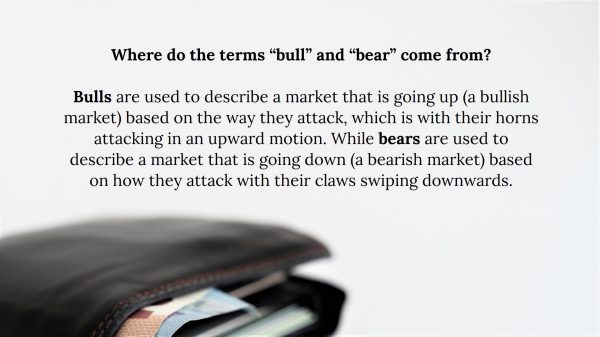“Simple but not easy” – a common expression. Indeed, in terms of trading or investing, the best techniques are often easy to learn but it’s difficult to execute them week-in-week-out.
Failing to be consistent or keeping up the routine is one of the reasons why so many fall short of their desired goals and wealth targets.
One of the main challenges that investors face is the dreaded pullbacks in the stock market. Today, we are going to talk about the three essential investor pillars that you should have in your investment plan that will help you to deal with the declines in the market and make it a much smoother process.
This article is originated from the podcast “3 Expert Ways To Deal with Turbulence In The Stock Market”, hosted by Kola Gbadmasi and Zaheer Anwari. Join us on iTunes or Spotify.
What Is A Pullback In The Market?
A pullback is also known as a correction or decline in the market. This is when the market moves down, displaying signs of bearishness against the overall bull trend of the market. In other words, the decline should only be temporary before it goes bullish again.
Since 2009, the US stock market has moved up over 610% making it the longest bull run in history, but it has not done this in a straight line. The general direction has been upwards, but there have been declines along the way as well – some are actually quite significant.

Pillar 1: The Natural Rhythm of The Market
Now, let’s dive into our main topic today, the three pillars. The first one is to be aligned with the natural movement of the stock market. There are particular times of the year that declines are expected to happen: January to February, and September.
Using the figures of the S&P 500 as an example, we are taking you back to March 2009, where the market found support and the bull run started. The market moved up 61%, until a 5% decline in September.
Then, fast forward to 2012, there was a 16% bull run from January to September, until an 8% decline happened in September later that year. Then again, in 2014, after a decline of 6% in January, the following bull run was 16% for months until a decline of 9% in September.
In 2017, there was no decline in January. The bull run was 10%, and the decline actually came in August, which was 3%, before it rallied by another 10% for the rest of the year.
And in 2020, we of course felt the impact of the pandemic for the very first time. We saw an immense panic in the market causing it to fall by 35% from February to March. However, even the pandemic did little to reverse the market’s natural tendencies. The market from March 2020 rallied by 71% to February 2021. It was a big rally.
There was a correction of 4% in February 2021 followed by a bull run of 22%, and then another correction in September of 5% followed by an increase of 11%, before the decline of 12% came last month (January 2022).
It is important to note that the natural movement to the market does not happen exactly as stated every year. For example, a decline can happen in August instead of September, as well as unforeseeable circumstances such as pandemic. But we are trying to give you a general guideline and it’s good to get a hang of it.
It’s also difficult to predict how far price will decline. As we’ve highlighted, these declines can be of varying depths. This is the difficult part, and this is where the next level of technical analysis comes in, which is identifying and understanding support and resistance levels.
For the readers who are new to investing and the trading world, a support level is also known as a floor where the price comes down to and then bounces back up again. A resistance level is more like a ceiling where the price hits against and then bounces back down.

The 200-Day Simple Moving Average
The 200-day simple moving average is used to distinguish between a bull market and a bear market. It is a very good tool and indicator of the long-term trend.
When price is above the daily 200 simple moving average, the market has a bullish bias. And when price is below that, it has a bearish bias.
And just quick history on the 200 -day moving average: old school traders used to draw charts by hand and so, only very selective of the information is included in their charts. You can imagine having to draw thousands of charts by hand is an unbelievably long and laborious process.
Nowadays, we have the luxury of software that do a lot of the manual work for us. And this is why a lot of traders’ screens are lit up like a Christmas tree with every possible indicator, sparkling and cluttering their charts.
The best charts are always kept clean and simple, only a handful of tools and indicators are needed. Our focus as investors should always be on the price of the asset first and then use the right tools to determine if the bias of price is bullish or bearish.
And this is what we do here at Sublime Trading. Our logic is really simple: if it ain’t broke, don’t fix it. Instead of reinventing the wheel, take the wheel that is already in motion to get it working for you – especially if it’s been in motion for decades.

Pillar 2: Patience
We now live in the world of instant gratification and impatience. Because of the internet, people jump online and found “answers” from these so-called experts and analysts. Most end up panicking and as a result, they make hasty decisions which they end up regretting.
You can imagine the state of panic people have been in during these pullbacks. First, because of a lack of alignment with the markets’ movements, and then it is compounded when they get involved with social media.
This is a very amateur approach and a guaranteed way to blow the performance of your portfolio, which leads to very serious consequences.
What we have observed, however, is that these analysts have a history of calling tops and failing miserably. People need to learn to ignore the noise, ignore social media, and instead apply patience and follow the charts.
One of the first rules of investing is to ignore opinions, including your own, and to follow the charts. Charts are ultimately the only source of truth. So, going back to pillar one, if you learn how to align yourself with the natural movement of the stock market, you will make more consistent growth.
As each year that goes by, this is one less year of growth towards your desired wealth target by retirement. Remember, these so-called experts, whom you listen to now, won’t be around in your retirement years.
So, you are accountable for your choices. Only you. It is vital that you make the right choices from now going forward.

Pillar 3: Manage Your Portfolio Correctly (Ignore the Noises!)
The third pillar is to know how to manage your portfolio at certain times of the year. So, if we know pullbacks are likely to occur in January, February, and September, then depending on how experienced you are, you have a few options.
First, if you are new and still learning how to deal with the emotional aspects of investing, then January, February and September are great times of the year to lock in as much profit as possible. You can start rebuilding your portfolio once the market has settled and trends resume.
Good investment is being able to distinguish between a pullback and a total reversal of the market. The 12% decline we saw in January 2022 is a pullback. But the bear market in 2008 is a market reversal. It takes some time and experience to understand that, so don’t be too harsh on yourself if you’re still learning.
The second option is to cut out the weakest performing stocks and hold onto the strongest stocks. During the market correction, stocks will decline at varying speeds. For example, HubSpot declined by almost 40%. But Warren Buffet’s Berkshire Hathaway company stock increased by 4% in comparison.
This shows the importance of having a diverse portfolio from the start, made up of only the very best high probability stocks that are selected using a simple but strict analysis process. After that, remain calm during the market corrections and then manage each stock individually.
Most people will have stocks in their portfolio based on noises, such as Tesla and GameStop. And since there is absolutely no logic as to why they’re picked, these people have little idea how to manage these stocks.
And then, any signs of a pullback, they panic and then make decisions they come to regret later. This is an amateurish approach.
Remember, financial literacy is still extremely low in most adults. But you who are reading this can break that cycle: learn how to manage your finances correctly, learn a process that works, stick to a long-term investing routine, and be in a position to educate your kids because the schooling system is not going to do it for you.
And finally, the third option is for the more advanced investors and traders: when pullbacks come in, not only do you cut off the weakest performing stocks and hold onto the strongest performing stocks, but you also add new positions in your portfolio.
As Warren Buffet said, “when most are fearful, be greedy”. We prefer to say “be brave”. Market declines are a perfect time to buy stocks at a discount.
This requires an understanding of when to buy as timing is everything. Get it wrong and your losses will accelerate. Get it right and it will pay off handsomely.

The Three Pillar
- The Natural Rhythm of The Market: know the times of the year when pullbacks are likely to occur
- Patience: be patience and consistent in your investment
- Manage Your Portfolio Correctly: know how to manage your portfolio at certain times of the year based on your experience
Ready to step up your game? Sign up to our Sublime Mentoring Academies and Weekly Newsletters, and learn how to manage finance and your future. Yes, this is your future on the line – your financial security, your investments, your retirement – and ultimately, what you leave behind for your loved ones.
Don’t forget to take a look at our scorecard, go through the questions and see whether you are on track to a wealthy retirement. On completion, you will also get access to our FREE Launchpad Starter Kit to help you reaching your financial goals. And as always, keep it simple, keep it Sublime!



